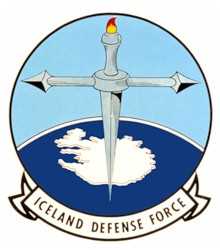Iceland Defense Force

.jpg)
The Iceland Defense Force (IDF) was a military command of the United States Armed Forces from 1951 to 2006. The IDF, created at the request of NATO, came into existence when the United States signed an agreement to provide for the defense of Iceland, which did not, and does not, have its own unified defense force.
Organization
The IDF was formally headquartered at Naval Air Station Keflavík, though its base was actually at Miðnesheiði near Keflavík. Commander, Iceland Defense Force was a U.S. Navy Rear Admiral with three other titles and roles: Commander, Iceland Sector ASW Group (CTG-84.1), Commander, Fleet Air Keflavik, and NATO Island Command Iceland. Commander Fleet Air Keflavik (COMFAIRKEF) was the senior Navy command in Iceland, responsible for the operational readiness of Navy units assigned. The commander of Fleet Air Keflavik was the operational commander in charge of all Navy and anti-submarine warfare operations. Administratively, COMFAIRKEF reported to Commander, Naval Air Force U.S. Atlantic Fleet, located in Norfolk, Virginia.
The IDF was a subordinate unified command of United States Atlantic Command for a long period before passing to the control of the renamed United States Joint Forces Command.[1] From October 2002 until its disbandment, it was under the control of the United States European Command.
The IDF was composed of United States Navy, United States Marine Corps, and United States Air Force personnel as well as local Icelandic civilians. In addition, there were a few Army and Coast Guard personnel attached to this command.
There were more than 25 different commands of various sizes attached to Iceland Defense Force. Although staffing varied over the years, it was approximately 1350 U.S. military personnel (not including Reservists), 100 Department of Defense civilians, and 650 Icelanders, both civilians and firemen given military training manning the local Naval Firefighting team, as well as military members from Norway, Denmark, Canada, the Netherlands, and the United Kingdom worked on NAS Keflavik. A contingent of the United States Marine Corps was responsible for ground defense.
The U.S. Air Force component of the force was the 85th Group. The air forces stationed in Iceland included a rotational P-3 Orion patrol squadron deployed forward from the U.S. Navy's Patrol Wings Atlantic, and the F-15s of the 85th Group. Commander Dennis Corrigan, Fleet Air Keflavik's operations officer, commented to Jane's Defence Weekly in 1996 that 'Keflavik is the only place where a US Navy flag officer has both P-3s and USAF F-15s working for him. ..We have developed a joint tactical doctrine: F-15s providing air superiority to allow the P-3 to do its job, whether its mining, anti-submarine warfare or something else.'[2] With the reduction in Patrol Wings Atlantic to ultimately seven squadrons by 1994, commitments at NAS Roosevelt Roads and Sigonella were reallocated, with Patrol Wings, Pacific taking up the Caribbean tasking to allow a full complement of P-3s in Sicily. [2]
In the event of a major ground threat, the Army component, U.S. Army Iceland (ARICE), would have mobilized and become responsible for the ground defense of Iceland. ARICE consisted almost entirely of reserve components (until 1994, the main formation was the Army Reserve's 187th Infantry Brigade) in the United States, and limited numbers of personnel participated in on-site training maneuvers.
Exercises
Operation Nordic Shield II was held in the summer of 1992. As they did five years before, units of the 94th Army Reserve Command; principally the 187th Infantry Brigade (Separate), the 167th Support Group (Corps) and their subordinate battalions and companies; deployed to Canadian Forces Base Gagetown in southern New Brunswick, to simulate the defense of Iceland against Warsaw Pact forces, the CAPSTONE mission of both the 187th and 167th. Part of the 1992 exercise included lanes training as part of the United States Army Forces Command's "Bold Shift" initiative to reinforce unit war-fighting task proficiency.
Termination
On 15 March 2006 the U.S. Ambassador to Iceland announced the decision of the United States to withdraw the Iceland Defense Force before the end of September 2006. On September 30, the American military withdrew its final four Air Force fighter jets and a rescue helicopter squadron from Keflavík.[3] Although NAS Keflavík has closed and the American military has left Iceland, the United States is still responsible for defending its ally and the facilities at Keflavík will still be available, in the event that a "surged expeditionary presence" is deemed necessary.[4]
The Icelandic defence contractor Kögun has been contracted to operate and service U.S. Navy communications equipment and facilities left behind.
See also
Further reading
- Jane's Defence Weekly 30 March 1991
References
- ↑ Iceland Defense Force
- ↑ 2.0 2.1 Joris Janssen Lok, 'No thaw in Cold War for Iceland,' Jane's Defence Weekly, 5 November 1994, p.15
- ↑ http://www.washingtonpost.com/wp-dyn/content/article/2006/03/16/AR2006031601846.html
- ↑ http://www.stratfor.com/geopolitical_diary_u_s_withdrawal_iceland